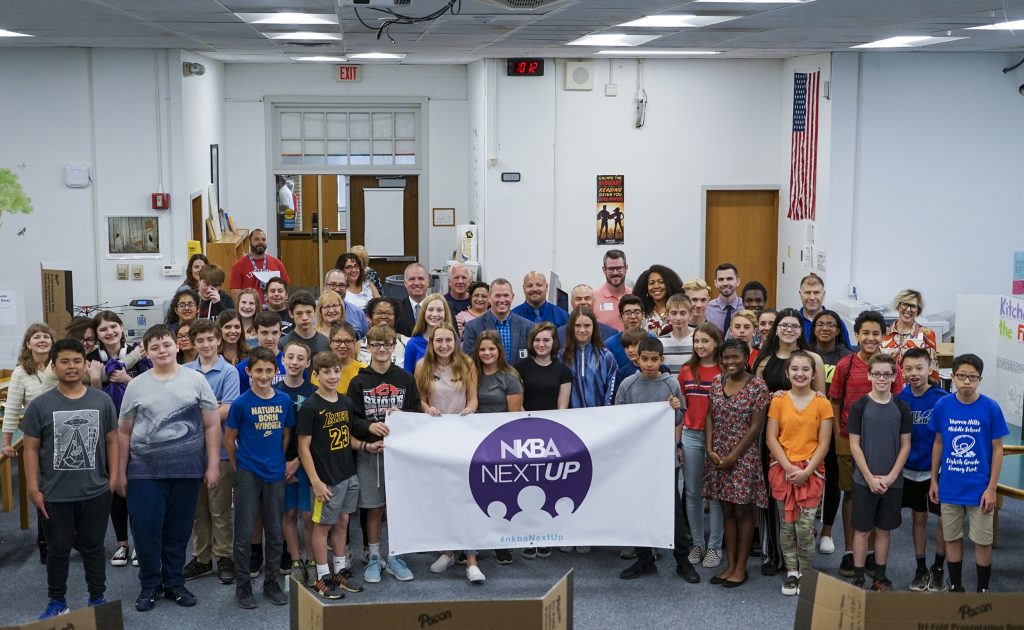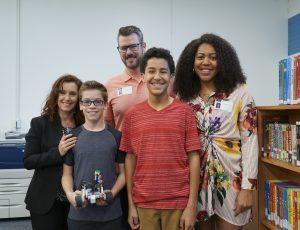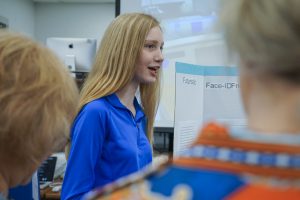
Credit: Francis Williamson, NKBA
Two middle-school competitions encouraged creative thinking, innovation and perseverance. By Dianne M. Pogoda
As part of NKBA’s NextUp program to build awareness of career opportunities in the kitchen and bath business, the Association recently sponsored a pair of contests at Warren Hills Regional Middle School in Washington Township, N.J., near its northern New Jersey national headquarters.
The initiative promotes professional pathways in the industry among young students, aiming to capture their interest and attention early in the decision-making process about what type of careers they might like to pursue. The NKBA hopes to develop this pilot program so it may be rolled out to more schools in coming years.
“I’m very excited to be here,” said Bill Darcy, NKBA’s CEO, “at a school I attended 35 years ago. Many things in life are changing very fast — but we all need a place to eat and take a shower, that’s not changing. It’s great to see what you’re participating in, because this industry is growing very rapidly, and there aren’t enough people to do these jobs. There will be about 750,000 open jobs in our industry by 2026. Hopefully, the effort you’ve put into your projects will inspire you to consider a career in a K&B-related field.”
Darcy served as a judge in the competitions, and was joined by NKBA Insiders Ryan Herd, a home technology expert, and designer Elle H-Millard, CKD.
“Science was my thing, and I’m lucky to be doing what I love in life,” Herd said. “You guys are the future — you have no limitations. You can draw up all the solutions, just think outside the box!”
Millard enthused, “I encourage you to keep the spirit of innovation alive!”
The two contests were designed to stimulate creative thinking to solve everyday problems in the kitchen. The point was to expose these seventh and eighth graders to the many and varied fields — from design, computers and robotics to building and craftsmanship — that comprise the kitchen and bath industry. Dozens of students participated in both competitions, with three teams in robotics and 15 product design projects showcased for the judges.
Larry Cascio, who has taught the robotics platform at the school for several years, said the biggest takeaway was learning that “what seems conceptually easy often is not, when you actually have to make it happen. So, perseverance is the key life lesson here.”
The first element was a robotics competition open to eighth graders in which teams designed motorized Lego robots to complete various kitchen

Credit: Francis Williamson, NKBA
tasks within an allotted time. The remote-controlled robots competed in a mini kitchen environment. Each of the three finalist teams completed at least one task, while the winning team succeeded in gripping and placing an object in a sink and in rolling across the kitchen, turning and manipulating a stove knob. This robot was created by Donovan McHenry and Christopher Smith.
Aliah Davis-McHenry, Donovan’s mother, said the project was valuable for stimulating innovative thinking to solve a problem, and teamwork.
“And it certainly reinvigorated Donovan’s interest in robotics,” added his father, Brian McHenry.
The second contest was designing a product for the “Kitchen of the Future.” It yielded 15 projects. The students presented their projects with a design statement illustrating their thought process and the problem they were trying to solve, and a drawing or prototype of their invention.
The prototypes included a number of app-controlled products; instant freezing units; dispensers that mix pre-measured baking ingredients based on programmed recipes; “The Eye,” a voice-controlled device that scans a kitchen to help vision-impaired people find things and move around the space safely; a unit that keeps plastic containers and their lids together and organized; a pulley system that lowers or raises a cabinet to help people reach its contents, and the “Omnifridge,” which includes a refrigerator, microwave oven, cooktop and storage in one compact unit.

Credit: Francis Williamson, NKBA
The judges admitted having a tough time deciding on one winner from this competition, and ultimately selected two champions. Simone North won for her “Future Face ID Fridge and Freezer,” which uses facial recognition software to grant access to the refrigerator. The design is programmable by parents and can protect children with allergies from accessing harmful foods, or help dieters, North said.
The other winning project was the K.N.I.F.E. — Knife Network Incorporation Feature Equipment. Hailie Lopez and Alexandra Porter designed a secure knife storage system incorporated into a countertop, featuring built-in sharpeners so each time a knife is extracted, it gets a fresh edge.
Robert Cacchio, vice principal and the department supervisor for tech education, said the program provided exposure to the tools and technology students normally wouldn’t get their hands on.
District superintendent Earl Clymer said the pilot was successful and the district will continue the collaboration with NKBA, growing and enhancing the program at the middle and high schools.
“The ability to take a creative idea from theory and put it into practice is invaluable,” he said. “It allows the students’ creativity to develop.”
Clymer added that building the robotics program at the middle-school level helps the high-school program, and gives students the tools to flourish.
“We were so impressed with the thinking process and creative execution — and marketability — of the projects on display,” said Darcy. “It was through brainstorming with my friend and high-school classmate, Daryl Detrick — who graduated from Cornell University with a degree in Engineering and now serves as the computer science teacher at WHRMS — that this collaboration came about. My vision is to start to engage young students when they begin to dream about what they want to be when they grow up. I hope they connect those dreams to the kitchen and bath environments they use every day — and it helps them understand they can earn a great living and have a wonderful career in our thriving industry.”








